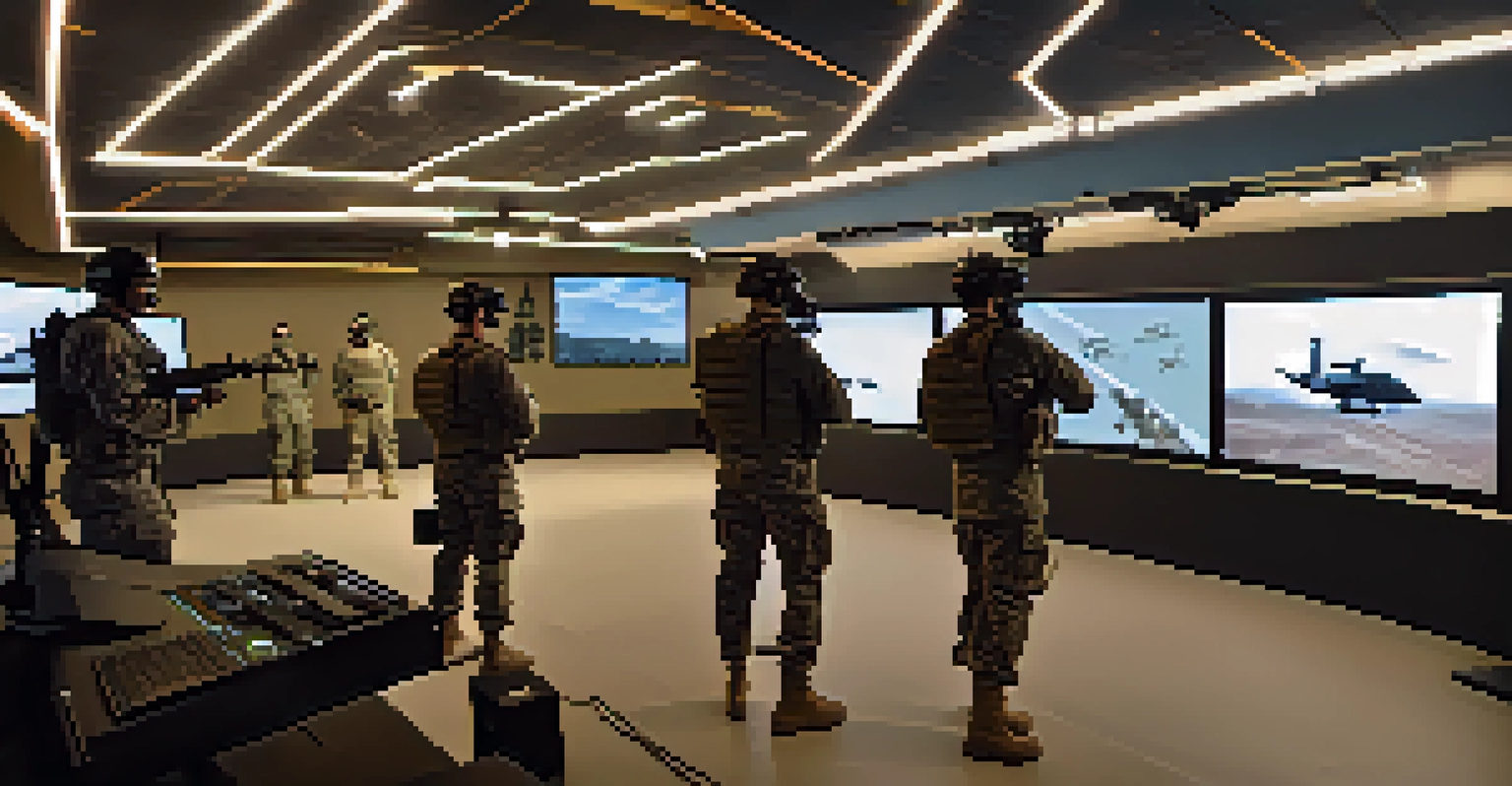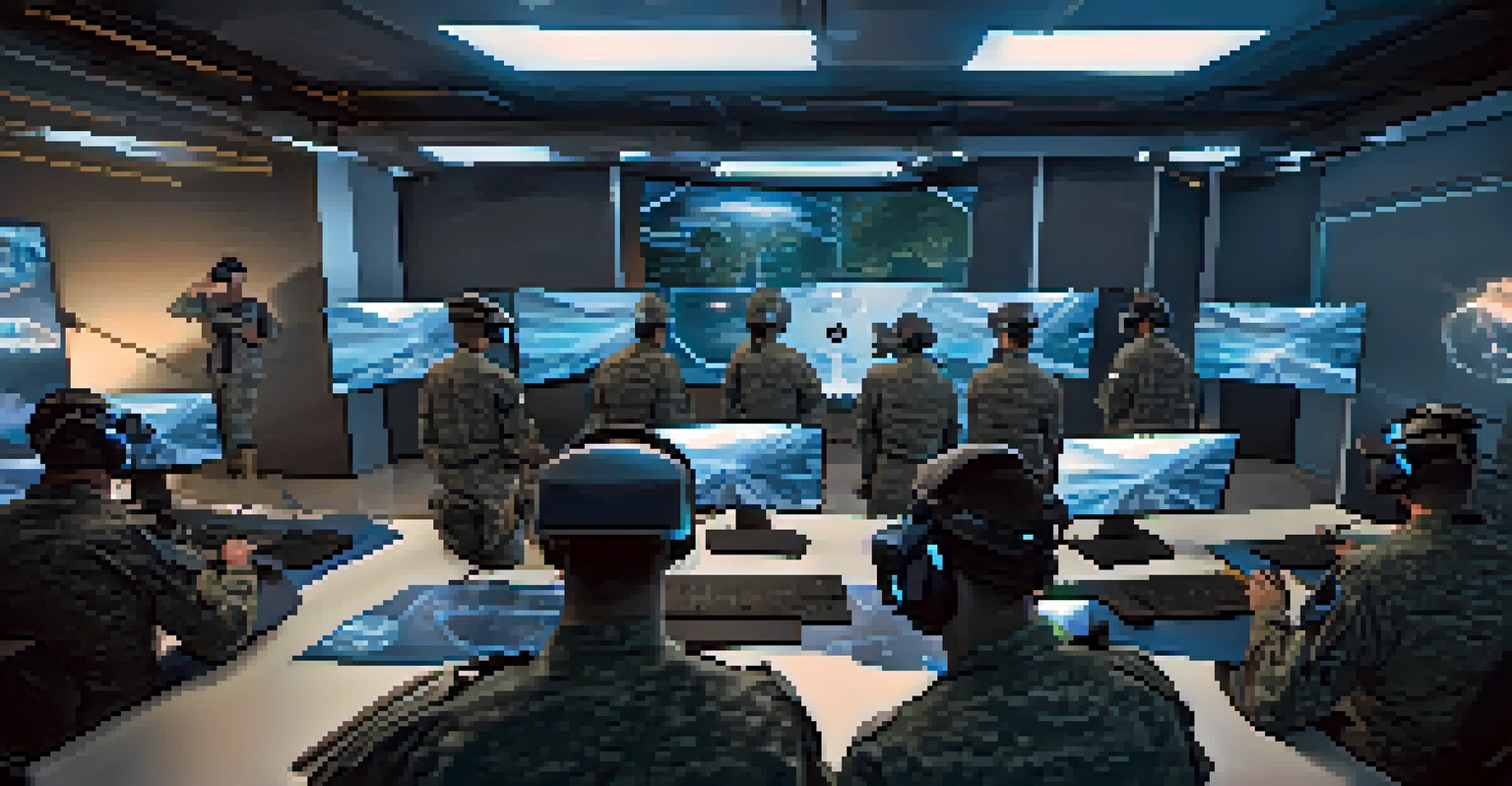The Future of Military Strategy Training Through VR Technology

Understanding VR Technology in Military Training
Virtual Reality (VR) has emerged as a groundbreaking tool in military training, offering immersive experiences that traditional methods simply can't match. By simulating realistic environments, VR allows trainees to engage in high-stakes scenarios without the associated risks. This technology brings a new dimension to learning, making complex strategies easier to grasp and remember.
Virtual reality is the perfect tool for training soldiers, allowing them to learn from their mistakes in a safe environment.
Imagine being able to practice battlefield tactics in a safe, controlled environment where you can fail and learn without dire consequences. With VR, soldiers can explore various outcomes of their decisions, gaining insights that are invaluable in real-life situations. This kind of experiential learning fosters deeper understanding and retention of military strategies.
As technology continues to advance, the potential applications of VR in military training seem limitless. From enhancing individual soldier skills to enabling team-based exercises, VR creates opportunities for innovation in how we prepare our armed forces. This shift not only prepares soldiers for combat but also instills confidence in their abilities.
Benefits of VR Training Over Traditional Methods
One of the most significant advantages of VR training is its ability to provide immediate feedback. In traditional training environments, feedback can often be delayed or subjective, which can hinder the learning process. With VR, trainees receive real-time evaluations, allowing them to adjust their tactics and strategies on the fly.

Moreover, VR can replicate a wide array of environments and scenarios, from urban warfare to natural disasters. This versatility means that soldiers can train for virtually any situation they might encounter. The ability to experience diverse scenarios enhances adaptability, making soldiers more prepared for unpredictable real-world challenges.
VR Revolutionizes Military Training
Virtual Reality provides immersive training experiences that enhance soldiers' understanding and retention of complex military strategies.
Additionally, VR training can be conducted remotely, which is particularly beneficial during times when travel is restricted or when resources are limited. This flexibility ensures that soldiers can continue their training regardless of external circumstances, maintaining readiness and operational efficiency.
The Role of AI in Enhancing VR Military Training
Artificial Intelligence (AI) plays a crucial role in enhancing the effectiveness of VR training programs. By analyzing data from training sessions, AI can customize scenarios that challenge individual trainees based on their performance. This personalization ensures that each soldier receives training that is tailored to their specific needs and skill levels.
The future of military training lies in technology that can adapt to the needs of individual soldiers, and VR offers a unique solution.
Furthermore, AI can simulate enemy behavior, creating unpredictable challenges that require quick thinking and adaptability. This dynamic aspect of training prepares soldiers for the complexities of actual combat, where no two situations are the same. The integration of AI makes VR not just a training tool, but an intelligent system that evolves with the user.
As AI technology evolves, the potential for creating even more sophisticated training environments will only increase. This synergy between AI and VR promises a future where military training is not only more effective but also more engaging, pushing the boundaries of what soldiers can achieve.
Challenges and Limitations of VR Training
Despite its many advantages, VR training is not without challenges. One significant hurdle is the high initial cost of VR technology and the infrastructure needed to support it. While prices are decreasing, the investment required can still be a barrier for some military organizations, particularly those with limited budgets.
Additionally, there is a learning curve associated with using VR technology. Some soldiers may initially struggle to adapt to virtual environments, which can hinder their training experience. Ensuring that all personnel are comfortable with the technology is vital for maximizing its effectiveness in training scenarios.
AI Enhances VR Training Adaptability
The integration of Artificial Intelligence allows for personalized training scenarios, challenging soldiers based on their unique performance.
Lastly, while VR can simulate many aspects of combat, it cannot replicate the full spectrum of human emotions and stresses experienced in actual warfare. This limitation means that while VR training is invaluable, it should complement rather than replace traditional training methods that build resilience and mental toughness.
Future Trends in Military VR Training Technology
The future of military VR training looks promising, with continuous advancements in technology paving the way for more immersive experiences. As graphics and sensory feedback improve, soldiers will be able to engage in training simulations that feel increasingly realistic. This heightened realism will enhance the learning experience and prepare soldiers for real-world scenarios more effectively.
Additionally, the integration of collaborative VR environments is on the rise. This means that soldiers can train together from various locations, fostering teamwork and communication skills. Such collaborative experiences are essential for modern military operations, where coordination among units can make or break a mission.
Moreover, the potential for incorporating haptic feedback—the sense of touch—into VR training could revolutionize how soldiers practice. Imagine feeling the recoil of a weapon or the impact of a simulated explosion. These tactile experiences could deepen the training impact, making soldiers better prepared for the realities of combat.
Case Studies: Successful VR Implementation in Militaries
Several military organizations around the world are already reaping the benefits of VR technology in their training programs. For example, the U.S. Army has implemented VR training for its soldiers, focusing on everything from marksmanship to tactical decision-making. This initiative has shown promising results, with soldiers reporting increased confidence and competence in their skills.
Similarly, the British Army has developed VR simulations for infantry training, allowing soldiers to experience various combat scenarios while honing their decision-making abilities. The feedback from these programs has been overwhelmingly positive, indicating that VR not only enhances skill acquisition but also promotes a culture of continuous improvement.
Challenges of VR Training Adoption
Despite its benefits, high costs and a learning curve present significant barriers to widespread adoption of VR technology in military training.
These case studies highlight the growing acceptance of VR technology in military training. As more success stories emerge, it is likely that other organizations will follow suit, further validating the effectiveness of VR as a training tool.
Conclusion: The Transformative Power of VR in Military Training
In conclusion, VR technology represents a transformative shift in military strategy training. Its ability to create realistic, immersive environments enables soldiers to learn and practice essential skills in ways that were previously unimaginable. By embracing this technology, military organizations can enhance readiness and operational effectiveness, ultimately saving lives.
As we look to the future, the integration of VR with AI and other emerging technologies will only enhance its potential. This combination promises to create training environments that are not only more effective but also more engaging, ensuring that soldiers are well-prepared for the challenges they may face.

Ultimately, the continued evolution of VR technology in military training signifies a commitment to innovation and excellence in preparing our armed forces. As we move forward, it will be exciting to see how these advancements shape the future of military strategy and training.